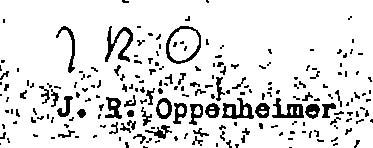
Trinity - First Atomic Bomb Test (page under development - currently conducting research and organizing this page; updated 1/10/14)
The Trinity Test was the first detonation of an atomic device on Monday July 16, 1945 at 5:29 am Mountain War Time on the Alamogordo Bombing Range in New Mexico. The location was 33 deg 40' 31" N and 106 deg 28' 29" W on the Alamogordo Bombing Range, New Mexico. The device had a yield of 19 kT and was detonated on top of a 100-foot steel tower. General Leslie Groves was in charge of the Manhattan Project to develop the first atomic bomb. The test of the atomic bomb was essential as noted by the Director and group leaders because of the enormous step from experiments and theory to a practical device. The Trinity device was referred to as the "gadget". No one believed that the first use of the Fat Man (F.M.) should be over enemy territory just in case it failed. Estimates of the yield gave from 100 to 10,000 tons with a most probable value of 4000 tons. Plutonium-239 was code named "49" which is derived from plutonium element 94 and isotope 239. Plutonium was discovered in January 1941 by Seaborg, Wahl and Kennedy by bombarding uranium with deuterons which created the 50 year half life alpha emitting isotope Pu-238 produced by the d,2n reaction. In March 1941, Pu-239 was found by Seaborg, Segre, Kennedy and Lawrence using the Berkeley cyclotron. The man-made Pu-239 isotope emits alphas and the half life was determine to be 21,300 years. The early chemical information from plutonium and its compounds were determined using Pu-238 (referred to as 48). Col. Stafford Warren was the Chief of the Manhattan Project's Medical Section and used this information to develop health and safety practices. The reaction for the production of Pu-239 from U-238 is:
U-238 + n -> U-239 (beta decay, 23 min half life) -> Np-239 (beta decay, 2.3 day half life) -> Pu-239
General Leslie Groves selected J.R. Oppenheimer from the University of California Radiation Laboratory at Berkeley to lead the development efforts for the first atomic bomb which was code named "Trinity". In March 1945, in a letter on the Test Measurements Program for Trinity to K.T. Bainbridge, he made the team aware that the test would be conducted outside of Jumbo. Jumbo was a very large container designed to capture the plutonium if there was problem with the test and only the high explosive went off. This was important for Bainbridge in determining instrumentation to conduct measurements during the test.

J.R. Oppenheimer signature 1945
The team that transported the plutonium to the Trinity site was monitored for dose and alpha contamination. The plutonium had been coated with silver to prevent contamination but standard precautions of dosimetry and gloves were used. the team received no evidence of contamination and the dose rate at the surface of the container was only a few time the long term tolerance value.
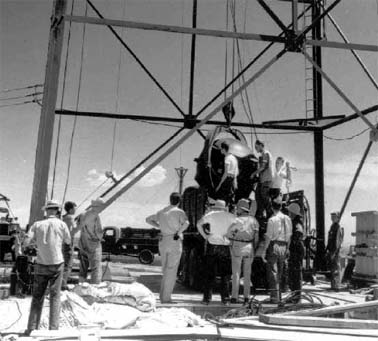
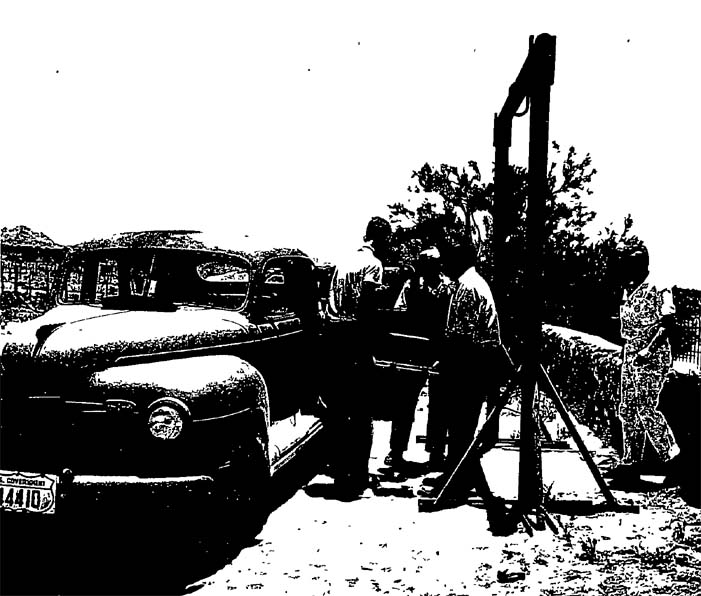
Trinity Device being raised to top of 100 foot tower (left) and Loading Plutonium in Car (right) 1945
The Trinity shot was preceded by a 100-ton rehearsal shot on May 7, 1945 which contained a Hanford irradiated slug from the reactor with fission products with beta activity of 1000 Ci and gamma activity of 400 Ci. The slug was dissolved in a solution and inserted into the center of 100 tons of explosives. The test was used to check the instrumentation that would be used for the Trinity shot.
This module is focused on portable radiation detection instruments used during the Trinity test and the follow-on ground and aerial based measurements.
R.J. Watt, at Los Alamos Scientific Laboratory (LASL), was assigned to setup all monitoring equipment for the test and instruct all monitors of their duties in October 1944 and to develop health instruments.
In April 1945, R.J. Watts from the Los Alamos Scientific Laboratory initiated the measurement plan for Trinity. The radiation hazards from the test shot were serious and ranked in the following order: 1) airborne alpha contamination, 2) airborne fission products and 3) direct gamma and beta radiation from the shot and fission products. At the time, there was no instrument to give an instantaneous reading of alpha activity in the air. As such, a project was started to to develop an instrument that would warn of dangerous air to breath over a period of 100 minutes. It had to be small, rugged and portable and should detect 100 cpm per liter of air. It was planned to use a thin windowed methane chamber to avoid microphonics. The recording gamma meter was already in operation. It used one thin wall metal G-M tube and could measure the betas from fission products. For the Roentgenometer's (this was a generic term for an ionization chamber meter), the plan was to use the triple range Victoreen survey meters. They ordered 36. The G-M survey meters were from Hallicrafters and 30 were available. These would be combined with the Victoreen instruments to cover the entire dose rate range projected of 0.001 R/8 h to 70 R/8 h.
For the higher intensities, the Victoreen Model 247 was used. Since the supply number of these was small, a one tube meter was designed called the Roentgenmeter or "Watts Meter". The meter covered the range from 0.04 R/h to 1 R/h in three ranges. These meters were also used for monitoring in the lead-lined tanks that would enter the blast site after the shot. An estimate was made of the instruments needed for the four towns, three shelters, base camp and those monitoring the cloud by automobile. The list included Filter Queens (10), Gamma-beta Recording Meters (15), Alpha Counters (15), Survey Meters (30), Neutron Counter with a boron coated counter (1) and Landsverk Electrometers (10) for a total of 81 instruments.
It was recognized that considerable danger would exist and that specialized instruments would be needed to warn of the danger. The danger include 1) danger at the instance of explosion, 2) danger fro the radioactive cloud and 3) danger from residual activity to people re-entering the blast site. The shelters at 10,000 yards were considered safe unless the cloud stayed low and sweep over the shelters. It was also a concern that the cloud might rise very high and then settle upon a town thirty of more miles away. The unburned plutonium near the blast site was an inhalation concern if distributed in the air. And lastly, the residual activity would be concern to those entering the active area after the blast consisting of total body gamma and beta and inhalation of radioactive material.
Each shelter at 10,000 yards was given an alpha meter, a beta-gamma GM meter and a Roentgenometer. The Base Camp had a Filter Queen and GM Recording Meter. At the surrounding towns, instruments were a Filter Queen and a Recording Beta-Gamma Meter. The automobile teams each had alpha meter, beta-gamma GM meter and Roentgenometer. The neutron meter was set up a the South Shelter with a clear view of the shot. No appreciable change was observed during the shot. Immediately after the shot, the proportional counter with the window facing the sky was set up. No activity was found.
On July 15, 1945, a final meeting of radiation monitors for the Trinity shot was conducted. Each monitor was assigned 1) a methane-filled proportional counter for detecting alphas, 2) a Victoreen Model 247, three range, portable gamma ray survey meter (it was noted as the most useful instrument for field work with ranges of 0.01-0.1 R/h, 0.1-1.0 R/h and 1-10 R/h) and 3) the Hallicrafters Geiger-Mueller Tube, Model 5, portable survey meter for gamma and gamma plus beta radiation (the two ranges were 0.00004-0.001 R/8 h and 0.0008-0.02 R/8 h). They were also given bottle to put soil samples in. The teams were sent to various cities around the Trinity site such as Roswell, Socorro and others. Beginning on July 17, the Watt's and Victoreen survey meters were used to conduct group surveys downwind out to tens of miles.
Several portable detection instruments were used to measure the fallout and radioactive contamination including Geiger-Mueller counters, portable gamma meters, portable alpha meters and Easterine-Angus recording gamma meters. The meters were used by teams dispatched with vehicles to monitor the downwind radiation levels many miles from ground zero. The measurements were either made holding the gamma meter one meter above the ground or from a jeep either moving or stopped.
The electroscopes and condenser air chamber methods were replaced with direct reading electronic instruments to permit rapid surveys and make possible complete surveys over areas or installations. The branch of electronics dealing with very small currents and pulses had not been extensively investigated. Extensive studies have been conducted and now possible to build satisfactory instruments. Portable alpha survey instruments "ionization produced by the alpha particles is collected by means of an electric field and returned to the circuit through a very high value resistor. The voltage produced across the resistor is measured and taken as an indication of the intensity of radiation".
Initial projections for instruments needed were alpha proportional counters (20), recording gamma meters (20), Roentgenometers (30) and G-M survey meters (30) to cover the mobile units, shelters and towns.
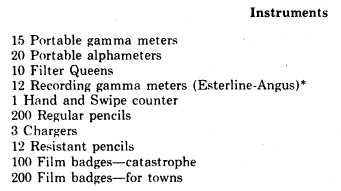
Radiation detection instrument list reported from the Trinity Shot, List 1
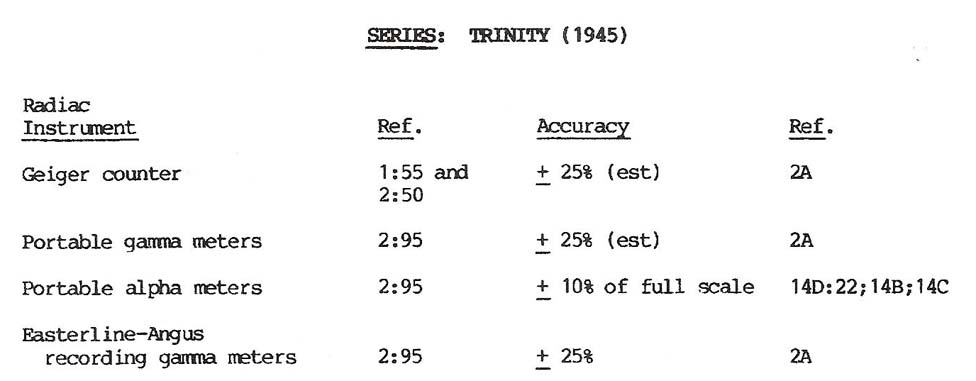
Radiation detection instrument list reported from the Trinity Shot, List 2
Radiological measurements were taken after the test typically by two persons teams - one U.S. Army and one civilian. The survey meters were placed on the ground or held waist high (1 meter). Teams reported taking measurements at "jeep-seat" level. Measurements were conducted for 3 weeks after the test and continued at irregular intervals for a least 6 months. Each team had a standard set of instruments to include a methane filled proportional counter for detecting alpha-particle radiation in the presence of beta plus gamma radiation, a Victoreen Model 247, three range (0.01-0.1, 0.1-1 and 1-10 R/h) portable survey meter and a Hallicrafters Geiger-Mueller tube, Model 5, portable survey meter for gamma and gamma plus beta with ranged of 0.00004 to 0.001 R/8 hours and 0.0008 to 0.02 R/8 hours. Some used a Watt's meter, small (one scale) Victoreen meter and a Landsverk and Wollan (beta plus gamma) quartz-fiber electrometer. The Victoreen Model 247 was used to take most of the measurements.
The following excerpt shows the radiation monitoring plan and radiation detection instruments for each task.
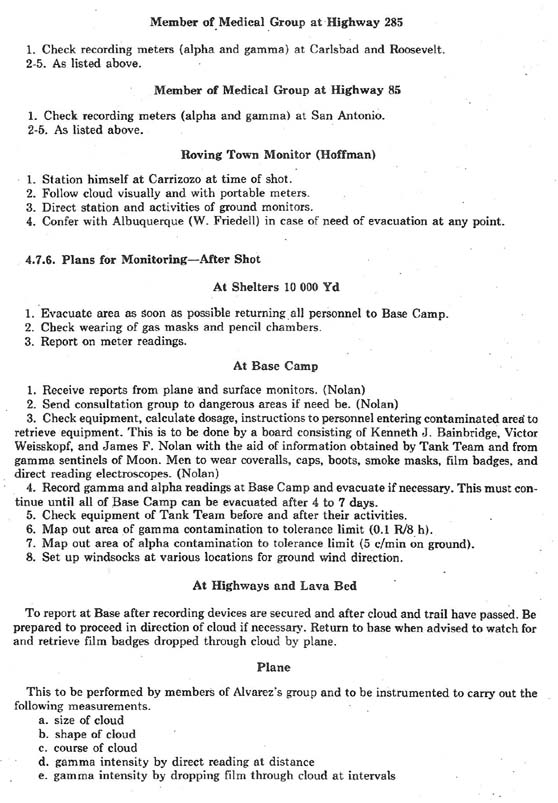
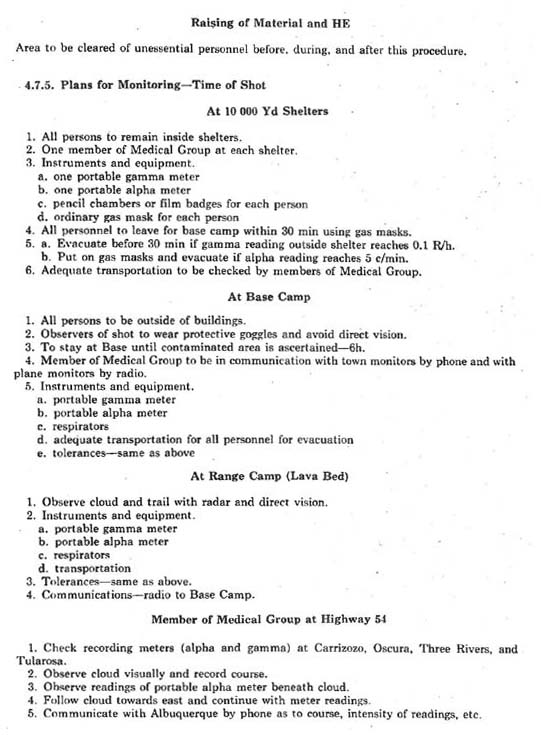

The following shows more information on the Off-Site Monitoring Plan and instruments used.
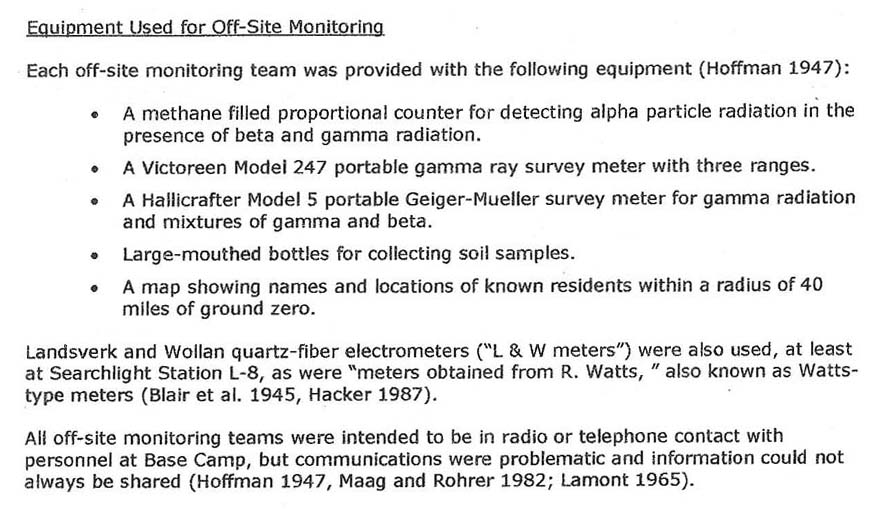

The following shows the measurement plan and instruments as requested by K.T. Bainbridge four weeks after the Trinity shot.
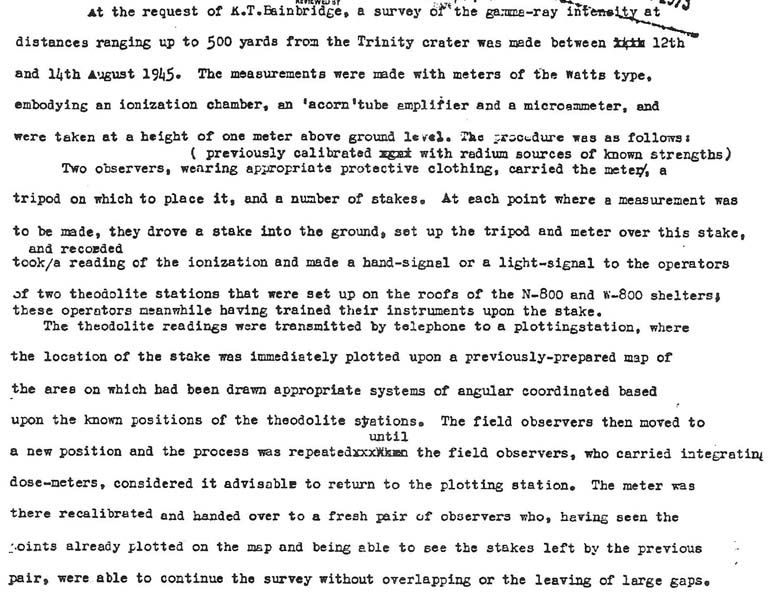
Equipment used for off-site monitoring consisted of a methane filled proportional counters for alpha detection, Victoreen Model 247 portable gamma ray survey meters with three ranges, and Hallicrafter Model 5 portable Geiger-Mueller survey meters. In addition, the Landsverk and Wollan quartz fiber electrometers were used at some locations as well at Watts meters.


Excerpt from Trinity Measurement Plan on Instruments
A normal boron coated counter and a standard aluminum beta-gamma counter were used outside the south shelter with a clear view of the shot. No appreciable change was observed during the shot or afterwards. Immediately after the shot, a thin window proportional counter was set up outside the south shelter with the window upward. No alpha activity was observed during the shot or afterwards. All shelters located north, west and south had radiological monitoring. Automatically recording beta/gamma counts were set up in four cities downwind to monitor fallout. Only one showed elevated readings.
Health safety concerns from radiation leading up to the shot.
The plutonium concerns developed in February 1944. The hazards were believed to be comparable to those in the radium industry. A group went to the Luminous Paint Company in Boston to learn about radium hazards and how they were handled in industry. There was a concerted effort to investigate instruments suitable for measuring alpha activity contamination of laboratories and personnel. The health instrument group in Chicago at the MET lab would build the instruments. The health group would work closely with medical. The first instrument for measuring alpha activity was the Pluto meter, a D-C ionization chamber developed by the Chicago Instrument Group. Since so few portable instruments existed, the monitoring technique was to swipe the desk surface with small pieces of oiled filter paper which were then measured with a stationary counter. This became known as the "swipe" technique. Since instruments were not readily coming from Chicago, R.J. Watts began development of alpha particle measuring equipment. A proportional counter using a methane-filled thin windowed tube was developed by Watts and installed in June 1944 to be used as a "hand counter" by persons leaving the building. By December 1944, Watts had developed a dozen of these instruments as well as a portable proportional alpha counter for monitoring laboratory surfaces for contamination. The portable instrument was called "Pee Wee". It weighed 19 lbs. and had a range of 0-20,000 counts per minute. Watts also developed a modified "Pee Wee" to monitor for neutrons.
One of the instrument developers was Howard Eberline who left the laboratory after the war and formed the Eberline Instrument Company in Santa Fe, New Mexico. He developed the first alpha scintillation type survey instrument.
Polonium was not considered as dangerous as plutonium so the less sensitive Pluto meters were used as monitors. The implosion studies in September 1944 using radioactive barium and lanthanum were the first to produce high external hazards. Later the critical facility at Omega was a health hazard concern. The three main concerns of the health group in 1944 at LASL were 1) protect personnel against industrial hazards, 2) investigate accidents or those leaving the projects, and 3) conduct routine exposure surveys and reports.
It was not clear that a suitable instrument for alpha activity could be developed with instantaneous indication since the tolerance dose for plutonium was 1 microgram. The issue was portability and portable instruments were known to be microphonic. It was possible to make an instrument that could count one or two counts per minute with the solution to the microphonics being solved by flowing methane through the chamber. Methane gave a factor of ten to air for signal to noise ration. Methane is also has a low ionization potential and thus a large pulse for amplification. To operate it, first turn on the methane until a small stream flows through the counter. The escaping gas is burned and the flame can be used as an indication of the gas flow. The air must be flushed from the counter and takes several minutes. The Alpha Counting Rate Meter instrument was bulky due to the small methane tank and the batteries but was on wheels for movement. The probe was on a long cable and could be monitored with headphones. There was a meter on the unit as well. The thin windows were made of collodian and held in place with glyptol. A wire screen was placed on the window for protection. The window was 3/4" x 5". A far more sensitive method of alpha measurement was using air filters and the Filter Queen.
For beta/gamma, two types of instruments were used since measurements from tolerance dose to 10 R/h needed to be measured. A Counting Rate Meter using a Geiger tube was used with a thin wall dural GM tube. This avoided the photoelectric effects common with glass GM tubes. The meter could be connected to a recording meter and put in place during the Trinity test. The least sensitive full scale was 0.01 R/8 h. The GM tube required 1000 volts.
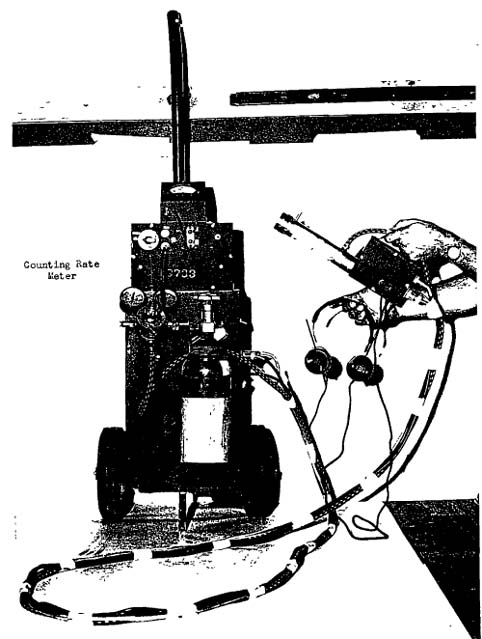
Alpha Counting Methane-flow Rate Meter with Probe 1945
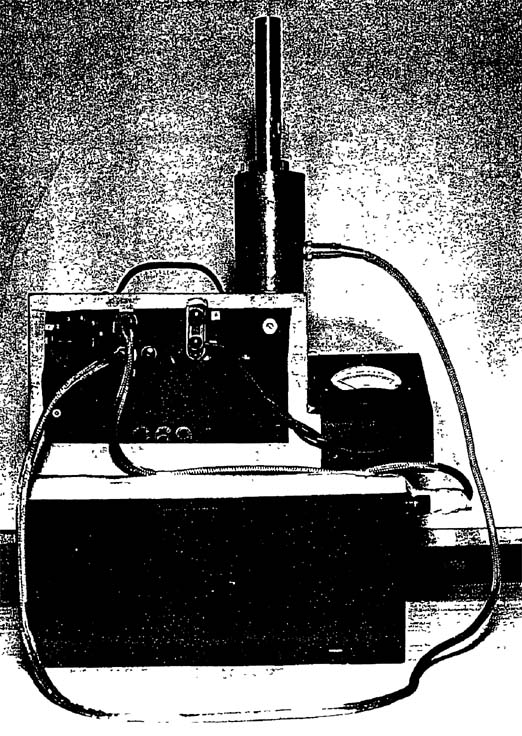
Geiger Tube Counting Rate Meter 1945
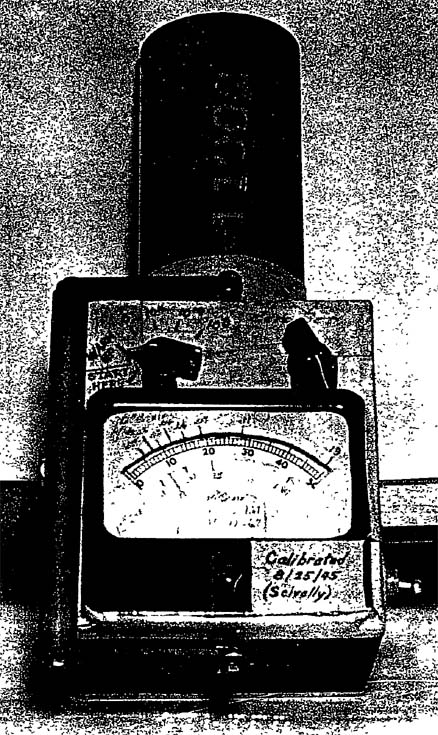
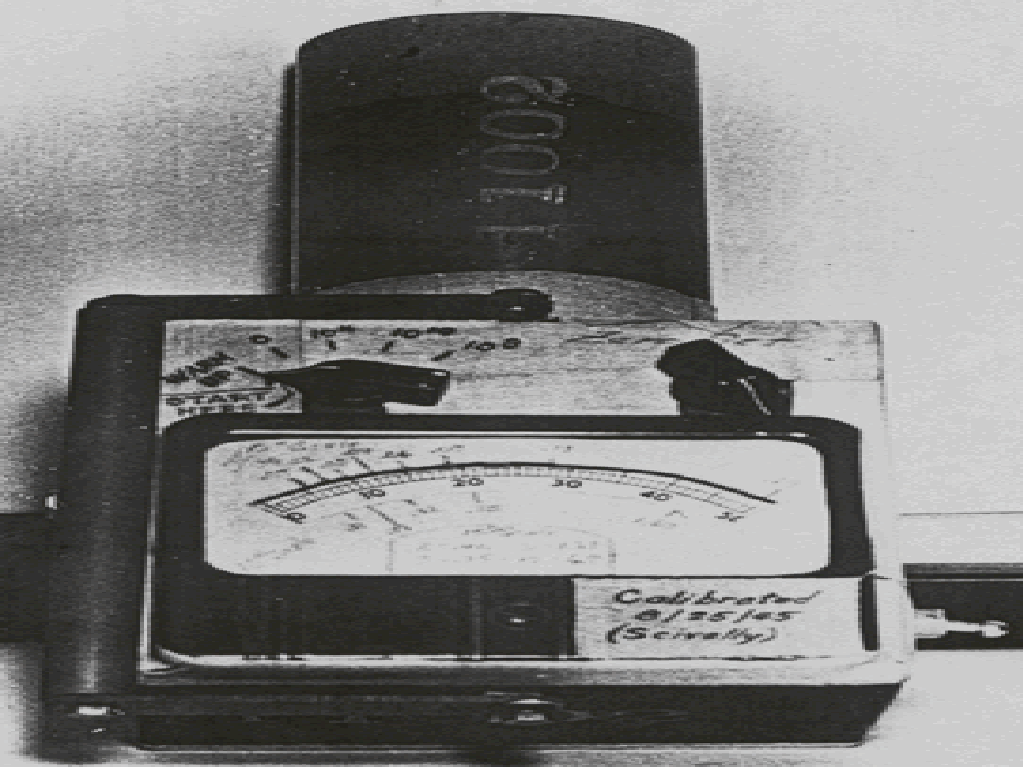
Roentgenmeter "Watts Meter" 1945
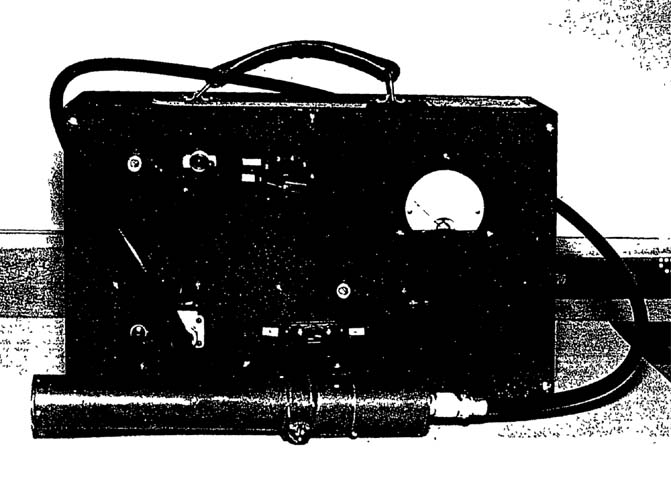
Neutron Counting Rate Meter 1945
The Victoreen G.M. gamma survey meter had three scale ranges of 0.01 to 0.1 R/h, 0.1 to 1 R/h and 1 to 10 R/h. The Model 247 was reported to be the most useful instrument. Some measurements were taken in a car with the meter on the front seat. The GM tubes detects individual gammas and betas so it is very sensitive. (1) Pictures used with permission of the Stafford Warren Collection at UCLA Charles E. Young Research Library, Department of Special Collections.
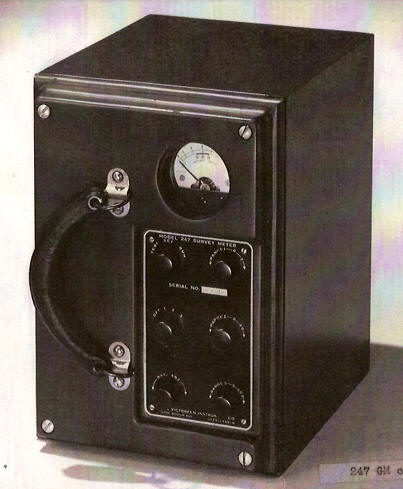
Victoreen Model 247 used for downwind post-test dose rate measurements 1945 (image courtesy of the Stafford Warren Collection)
The Hallicrafter Model 5 Geiger-Mueller survey meter was used for gamma and gamma plus beta measurements and had ranges of 0.00004 to 0.001 R/8 and 0.0008 and 0.02 R/8. The GM tube is contained within the instrument. The unit is 3" x 10" x 12" and weighs 14 lbs. It has two ranges of 0.12 and 2.5 mR/h. There is a battery check position on the selector switch. Four recessed screwdriver controls are available for high voltage, sensitivity, voltmeter for high voltage and bias adjustment for the integrator tube. THe GM tube was located inside the instrument box.
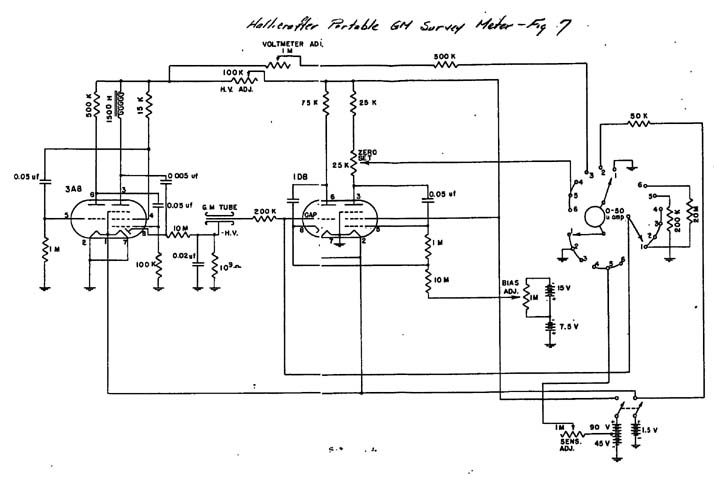
Hallicrafter Model 5 Geiger-Mueller Survey Meter Schematic 1945 (need photo)
The Victoreen Model 263 was also employed at Trinity in its early format. The probe was attached to the outside of the instrument box and could be extend with the cable. This allowed for much greater flexibility than the Hallicrafters instruments. This unit also allow the attachment of earphones so very low levels could be measured in a noisy laboratory. The gamma measurement was obtained with the shield around the Geiger-Mueller tube and the beta plus gamma acquired with the shield open. The Model 263 was used at Trinity for downwind measurements as early as November 1945. It was capable of detecting feeble beta and gamma radiation using the No. 3 setting on the Model 263 and the 0.2 setting on the Model 263A. It could detect the radiation from luminous paint on wrist watches. The unit has three ranges - 0.2, 2.0 and 20 mR/h. Since the tolerance limit was 12 mR/8 hr day, 6 days a week, for a lifetime, without ill effects, this instrument was well suited in that measurement range.
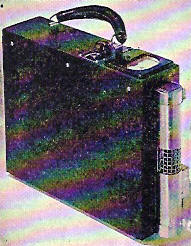
Victoreen Model 263
The first large area plutonium contamination incident occurred in New Mexico in 1945 with the first test of a plutonium fission device. As such, a team was established to investigate the distribution of the unfissioned material. The portable methane alpha particle counter was used which had a windowless methane flow proportional counter, a set of earphones and a rate meter. They were fastened to a metal box with a suitcase handle and containing 70 lbs. of batteries. The unfissioned plutonium in the area was below detectable limits. Not a single click was heard after crisscrossing the site several times. The story is that "when they left and headed south, they came across a car with a flat tire. They stopped and assisted by detaching the alpha probe from the rubber tube and the methane tank was used to inflate the tire".
In February 1946, Watt's and GM counters were used with flight surgeons on aircraft at various altitudes from 15 to 1400 feet over the test site to conduct pilot and monitor training over the "hot" area.
The Landsverk and Wollan meter was a beta plus gamma survey meter. It measures 3.5" x 5.5" x 6.5" and weighs 5 lbs. It has two ranges of 100 and 2500 mR/h. A sliding panel permits measurement of soft and hard radiation. It has rugged construction. It has a built in timing light. It is reliable but not direct reading and thus not very useful for survey work.
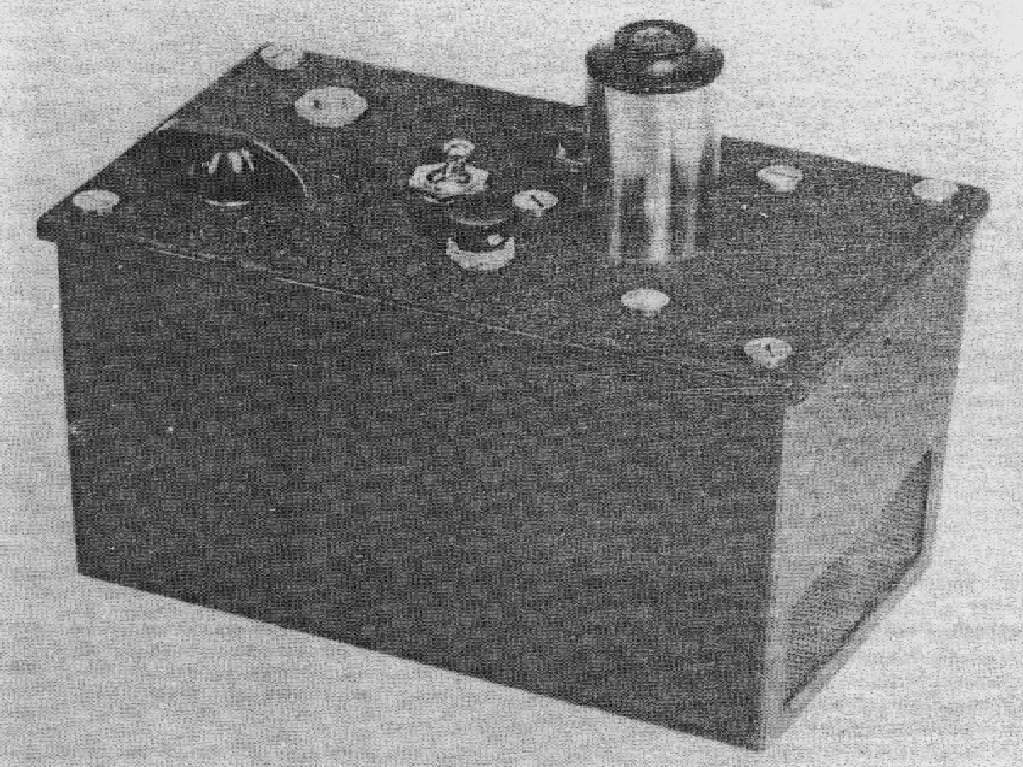
Landsverk and Wollan Beta Gamma Survey Meter 1944
Plutonium could not be detected directly until 1945 by the Pluto developed by Watts. They had no windows and could only detect large amounts of activity, but they were the only thing available. In December 1945, the Pluto, Zeuto, Zeus and Pee Wee were being used for alpha surveys. The Pluto, Zueto and Zeus are D-C amplifiers. In these instruments, ionization is produced by the alphas by means of an electric field and returned to the circuit through a very high value resistor. The voltage produced across the resistor is measured and taken as an indication of the intensity of radiation. The Pluto was the first instrument developed and the only instrument available for use in the laboratory for a long time. It was 3.5" x 5.5" x 10.5" and weight 7 lbs. 12 oz. The sensitive chamber area is 100 cm2. Various probes can be attached via a connector on the front of the unit. One special chamber is the "Snout", a long tin cylindrical chamber permits the monitoring of small area, and the "Plutolux", a flat chamber (4"x18") mounted on wheels with a handle and a place for carrying Pluto used for monitoring floors. The Pluto full scale reading is 25,000 cpm, where as the Zueto is 2,000 cpm with a second range of 20,000 cpm. The Zeuto is 5" x 5.5" x 10.5" and weighs 9 lbs. 4 oz. A nylon screen (0.00015 inches thick) covers the chamber to protect from dirt and moisture. The Super Zeuto is similar in size and operation to the Pluto except that it has a faster feedback response. It has two ranges 2000-5000 cpm and 20,000-50,000 cpm. Zeus is similar in sensitivity to the Pluto but has two more scales of 100,000 cpm and 2,500,000 cpm. For alpha and beta, the chamber is directional. It is 6" x 6" x 12" and weighs 11 lbs. 8 oz. They are all sensitive to beta/gamma but 1000 times less sensitive than the alphas. The Pee Wee is a portable proportional counter. It is an open sided GM tube operated in air at atmospheric pressure and can detect alphas in the presence of beta/gamma radiation. Two range include 2,000 cpm and 20,000 cpm. It was considered the most valuable alpha instrument at that time.
The Super Snoop was a mobile, battery operated, alpha survey meter of the proportional counter type. It used continuous gas (methane) flow for the detector. It has four ranges of 150, 500, 4,000 and 12,000 com. Individual pulses are easily detected.
The Zeus and Beckman Portable Survey Meters have thin walled chambers to allow beta but not alpha. I slide cover can be used to stop the betas and detect only gammas. The Landsverk and Wollan Electrometer is a portable instrument in which ionization produced by radiation discharges the voltage on the electrometer scale. A comparison of the time necessary to discharge the fiber with a calibration chart determines the radioactivity.
The post-shot radiation monitoring was conducted by Los Alamos scientists with assistance from military personnel.

Recovery team and radiation monitoring crews assemble a few hours after the Trinity test
Soon after the test, two Sherman M-4 tanks, painted white and shielded by 2 inches of lead, ventured into the crater. The lead added 12 tons to the weight of the tank. The tank had two Watt's type radiation meters with ranges of 0.1 to 100 R/h. The meters were mounted on the front of the tank 24" above the ground. A third meter was on top of the tank and a forth inside the tank. There was a trap door to collect soil samples. The data was radioed in by the crew who were collecting dirt samples. One hour after the shot, the tank made an initial run starting from the south at 10,000 yards and driving to within 120 yards of the crater center. The second run was 8.5 hours after the shot running in from the west to within 30 yards of the crater center. The tanks were previously used for the Radiolanthinum (RaLa) measurements at Los Alamos Scientific Laboratory. The tanks were modified to have two internal chambers with 2" lead walls to protect the driver and observer.
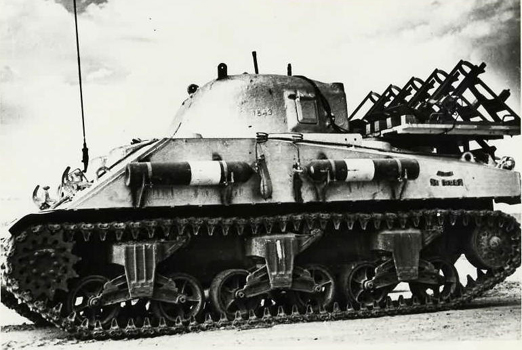
Lead-lined Sherman M-4 Tank used at Trinity to recover soil samples near ground zero 1945
Gamma-ray Sentinels were used to measure the delayed gamma activity in the vicinity of the shot. The instrument has a small ion chamber which charges a condenser and an enclosed spark-gap which breaks down when the condenser reaches a pre-determined voltage. Forty-four units will be used and placed a various positions and distances around the shot tower.
In order to monitor the surrounding villages, mobile teams with Landsverk and Wollan electrometers and radio-equipped cars will be downwind for 30 miles surrounding the test site. The operators will not have authority to force evacuation of people.
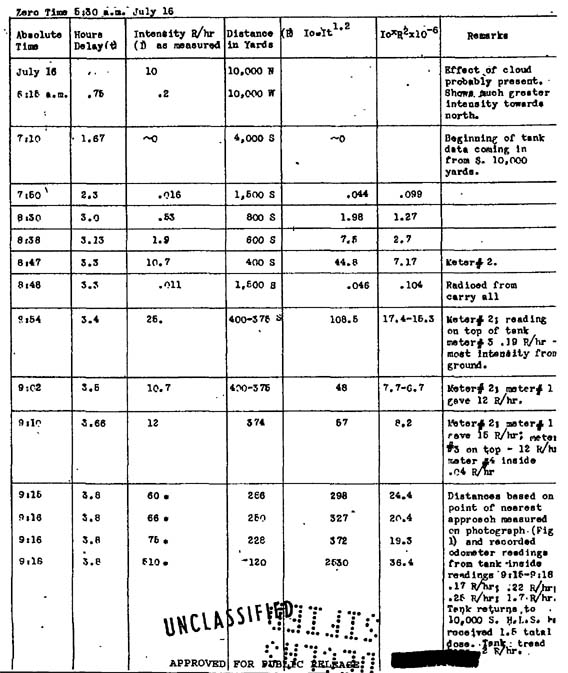
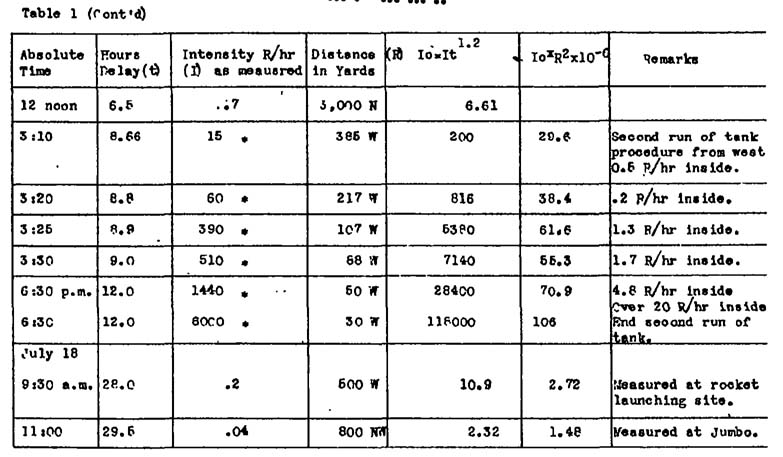
Tank Dose Rate Measurements Starting within One Hour of the Trinity Shot conducted with a Lead-lined Tank 1945
Watts developed an alpha meters accurate to 5 counts/minute to monitor the crater area for alpha contamination.
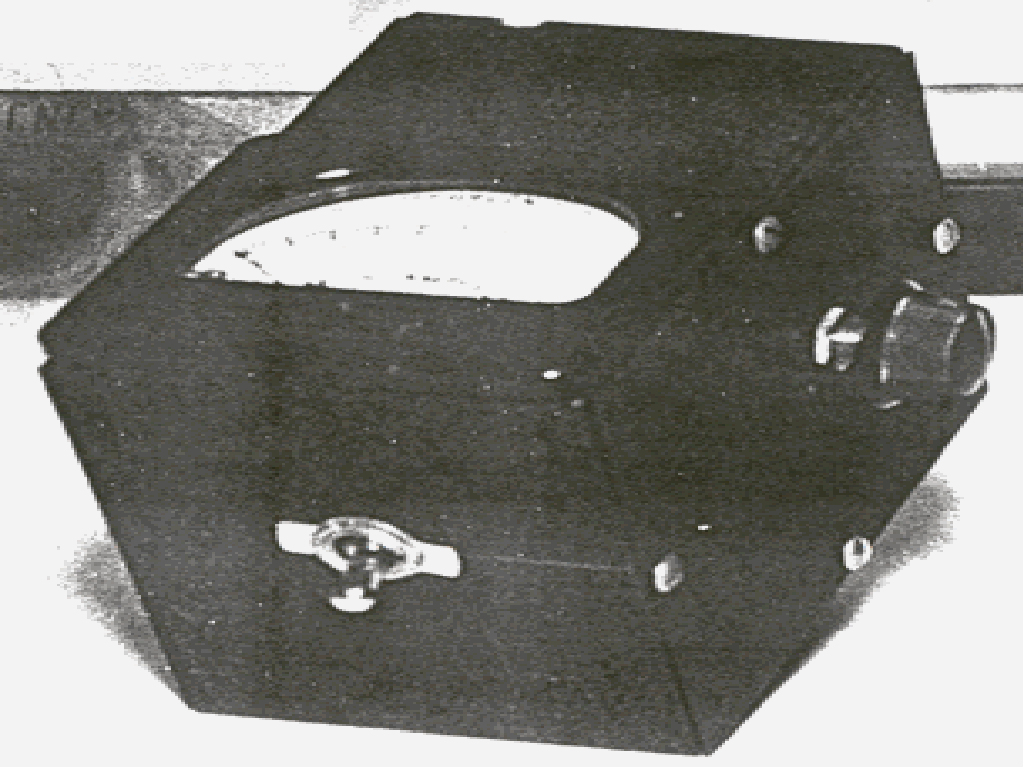
Los Alamos Roentgenometer Super Suds 1945
Another Watts alpha meter was developed in 1944.

Alpha Survey Meter 1944
The Filter Queens were modified vacuum cleaners used to collect air samples of the radioactive material on filters. The filters were counted with a special detector on the unit called a "Long Tom". The Long Tom is a standard alpha counting instrument with the chamber adapted to receiving a tubular sample. Each air sample is collected over several hours thus giving an integrated value. (1) Pictures used with permission of the Stafford Warren Collection at UCLA Charles E. Young Research Library, Department of Special Collections.
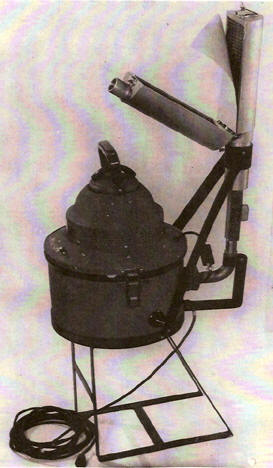
Filter Queen 1940's (image courtesy of the Stafford Warren Collection)
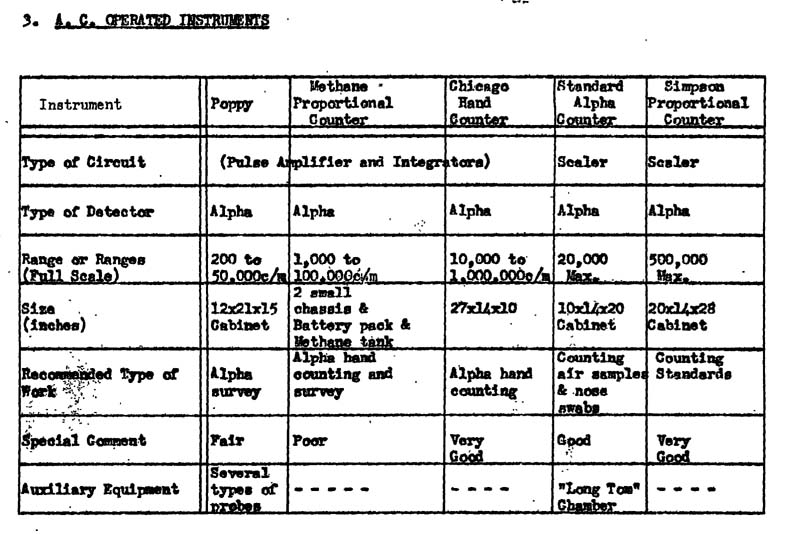
Instrument Chart for AC Operated Instruments 1945
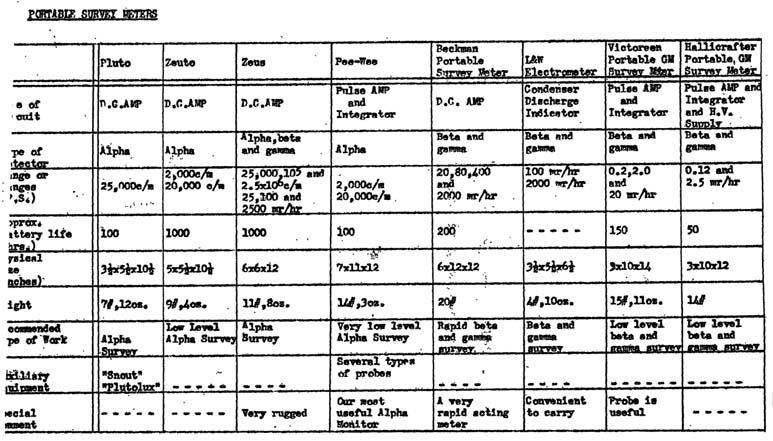
Instrument Chart for Portable Survey Meters 1945
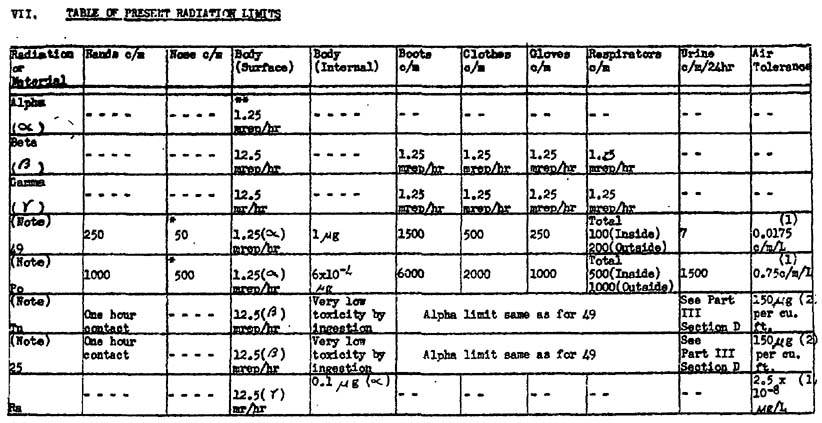
Radiation Limits Aug 1945
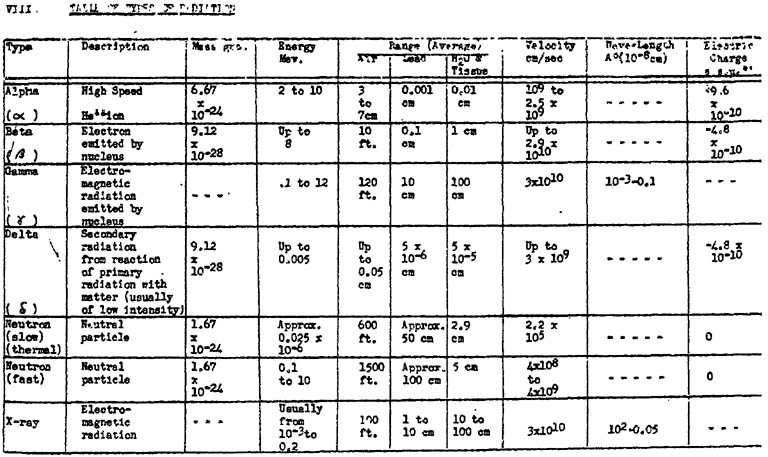
Radiation Properties Aug 1945